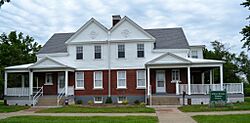Jefferson Barracks Telephone Museum facts for kids
The Jefferson Barracks Telephone Museum is a fascinating place to explore the history of telephones! It's located at 12 Hancock Avenue in Lemay, Missouri, which is part of St. Louis County, Missouri. This museum is found within the large, 426-acre Jefferson Barracks Historic District. This historic area was added to the National Register of Historic Places in 1972 because of its importance. The museum itself is inside a beautifully restored building from 1896. You can find it about a 15-minute drive south of downtown St. Louis.
About the Museum Building
The building where the Jefferson Barracks Telephone Museum is located was originally built in 1896. It was designed as a two-story duplex, meaning it had two separate homes inside. The design followed a special plan called Quartermaster Plan 115. Richard Deutman and Son architects built it. This building is one of only two structures left from "Officers' Row." This was a special area where military officers lived.
Life at Officers' Row
Officers' Row was on the north side of the main parade grounds. The parade ground was a central area where soldiers practiced drills and held ceremonies. The way the houses were placed around this area showed the different ranks of the military officers. Officers lived on the northern edge, showing their higher status.
Building Changes Over Time
Over the years, the building changed. In 1909, electricity was added, bringing modern power to the homes. Bathrooms were installed in 1925, making them more comfortable. Later, in 1938, sunrooms were added to the second floor. The areas on the first floor below these new rooms were also made larger. Military officers and their families lived in these duplexes until the mid-1940s.
Restoration by Volunteers
The museum building was carefully repaired and updated by volunteers. These volunteers are members of the Telecom Pioneers. This group is a non-profit organization made up of telephone company employees, their families, and friends. They have spent over 66,500 hours working to restore and renovate the building. Their hard work helped create the museum you see today!
History of Jefferson Barracks
Jefferson Barracks played a very important role in the history of the United States. It was a key place for westward expansion. Soldiers trained here before heading out to explore the western parts of the country. They also protected trade and settlements along famous trails. Many important forts in the West were started and supplied from Jefferson Barracks.
Building Periods at the Barracks
The historic district has buildings from three main periods of military construction:
- Buildings from the 1850s, used for storing ammunition.
- Buildings from the 1880s and 1890s, built using standard plans for military posts across the country.
- Buildings connected to the military build-up during World War I and World War II.
Important "Firsts" at the Barracks
Jefferson Barracks was home to many "firsts" in U.S. military history:
- During the Civil War, it had one of the nation's largest military hospitals. Doctors there made big improvements in treating wounded soldiers.
- It was the U.S. Army's first basic training center.
- The First Dragoons, who were the first American cavalry, were organized here.
- The first successful parachute jump from an airplane happened at the Barracks.
- The first Army Air Corps Technical Training School operated here.
Role in Western Trails
The Barracks also helped protect travelers and traders. It provided the first military escorts for merchant trains on the Santa Fe Trail. Troops from here also went out to explore and protect people on the Oregon Trail. It was a central hub, sending soldiers and supplies to many western forts during the various Indian Wars.
Famous Leaders Who Served Here
Many American military heroes served at Jefferson Barracks over the years. Early leaders like Thomas Atkinson, Henry Leavenworth, and Henry Dodge were already famous from the War of 1812 before coming here. Because of its size and importance in the mid-1800s, many young officers from West Point served here. This group included hundreds of future Civil War generals, both for the Union and the Confederacy. Famous names like Ulysses S. Grant and Robert E. Lee served at Jefferson Barracks. Later commanders, such as Guy V. Henry, Walter Krueger, and Walter C. Short, played leading roles in the Spanish–American War and World War II.
Museum Exhibits
The Jefferson Barracks Telephone Museum has a huge collection of interesting items. You can see telephones made from the 1900s all the way through the 2000s.
What You Can See
- A working Central Office Step Switch, which is a big machine that used to connect phone calls.
- Military telephones used in wars from World War II to the Vietnam War.
- Hundreds of pieces of telephone equipment and tools.
- A real telephone pole with climbing gear, so you can imagine what it was like to work on them.
- Lots of telephone-related items from the 1880s to the 2000s.
- A wide variety of fun and unusual novelty telephones.
- A special portable switchboard that was set up when U.S. Presidents Carter, Ford, Nixon, and Johnson visited St. Louis.
- A sculpture of Alexander Graham Bell and information about how he invented the telephone.
Hands-On Learning
The museum is designed for you to explore on your own. Many of the displays are "hands-on," meaning you can touch and interact with them. This helps you understand how things work. The exhibits are made to spark your interest in engineering and history. Boy Scouts can even use the museum to help meet requirements for their Inventing and Engineering merit badge. If you have a group of 10 or more, you can schedule a guided tour. Just make sure to book it at least two weeks in advance!


